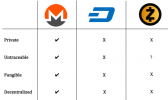We live in an age where much of our lives are online, and privacy has become an important issue. In some countries with oppressive governments, or where censorship exists, privacy can even mean the difference between life and death. This is where Monero comes into play and ensures privacy for the people.
Monero is a fungible cryptocurrency that focuses on anonymizing transactions and establishes a private, censorship-resistant token that can be used to transfer value around the world. Through the use of a powerful privacy-focused protocol known as CryptoNote, Monero has been able to show that transactions of value can indeed remain private from prying eyes.
What Does Monero Do?
To better understand what Monero does, here is a comparison of Bitcoin and Monero in Figure 1 below:
Figure 1: Comparison between Bitcoin and Monero.
A common fallacy that still exists is that Bitcoin is a private and untraceable cryptocurrency that cannot be tracked. The reality is that Bitcoin is well known for using a public ledger (blockchain) that contains an immutable list of transactions of everyone that makes use of the Bitcoin ecosystem. The use of a public ledger can be useful in order to verify transactions maintain integrity and confidentiality (through pseudonymity) but this doesn’t necessarily mean Bitcoin is private.
Since there exists a public ledger for every transaction made on the Bitcoin network, all transactions and its metadata can be seen for any Bitcoin public address. This means that every single transaction made for that public address will remain visible from the starting point of when the first transaction is made until the most recent transaction.
Monero, on the other hand, functions by using a cryptographic protocol known as CryptoNote. The technology that is the foundation for Monero aims to make transactions untraceable, and therefore the balances of XMR tokens remain confidential.
Privacy in the financial technology sector is becoming increasingly important as there are more security breaches that occur where financial information (such as credit card data) is stolen. Monero combats this by making it a default attribute where all transactions remain hidden from the public through the use of its powerful technology — which is described in more detail below.
Unlinkable Stealth Addresses
A big factor that distinguishes Bitcoin from Monero is the notion that Bitcoin addresses are generally re-used for multiple transactional activities. All incoming and outgoing transactions and metadata remain publicly visible to everyone with just the public address.
Although the entity has not revealed their identity, their transactions can be traced to this single address which can be used for further analysis if a malicious entity targets it. Through analyzing common patterns and linking amounts of value coming in and going out of the wallet address makes it easier to determine the identity of the person that owns the address.
On the other hand, when using Monero to transact, the destination addresses are only identifiable by the respective sender and receiver. The Monero blockchain does not show the destination address that receives XMR token(s), but instead, shows the cryptographic hash of the receiving address (which is separated from the sending address). The only entity to reveal the destination address is the sending or receiving party.
Through the use of a secret view key, the recipient is able to determine how much XMR was sent to them using this unlinkable address – separate from their public address. These type of hardened addresses are known as stealth addresses.
Figure 2 shows the Monero block explorer that makes it extremely difficult to determine the real public address and outputs of a transaction towards it.

Figure 2: Monero block explorer.
Untraceable Ring Signatures
Monero enables the untraceability of the currency through the use of a technology known as ring signatures. Ring signatures allow transaction mixing to take place which adds another privacy-enhanced feature. The process of transaction mixing allows a sender to randomly choose several other potential signers (from the beginning of the 1st genesis block) to send the XMR over the blockchain network.
The main thing to understand here is that ring signatures guarantee that no person can decipher where the funds came from since everyone is a potential signer in a group signing pool. Figure 3 shows how untraceable ring signatures process in Monero. Ring signatures make it difficult to trace a transaction back to a specific IP address corresponding to the transaction sender or receiver, which adds to the list of wins for privacy and anonymity.

Figure 3: Untraceable ring signatures in Monero.
History of Monero
The history of Monero can be traced back to April 2014, when BitMonero (the original name of Monero) came into existence by forking Bytecoin. Bytecoin was also a fork from the CryptoNote protocol (even though it is not a digital currency), as CryptoNote focused on the technicalities and cryptographic capabilities of achieving true privacy/anonymity.
CryptoNote was known for its innovative ring signatures that now fuel the privacy features that Monero takes pride in. Since Monero really focuses on transactional anonymity, Monero’s blockchain is designed to be transparent by default and it is impossible to trace activity back to an individual public address, unlike with Bitcoin.
The Monero Team
The core developer team at Monero consists of highly talented individuals with a keen eye for privacy and anonymity. Of the seven core developers, two are publicly known – Riccardo Spagni and Francisco Cabañas, while the other five are pseudonymous.
Alongside the core team, Monero has had over 200 contributors to the project over the span of its life. Monero also goes through development upgrades that normally add updated features and improvements to security nearly once every six months. A schedule like this allows Monero to continue growing and ensures that the core team and all of the contributing developers are able to adapt to these changes, ultimately allowing the Monero ecosystem and network to evolve.
You can get more insight into the team of core developers and active contributors here.
Competitors
As privacy is a big concern in the cryptocurrency realm, multiple digital tokens exist to provide privacy using different cryptographic protocols, techniques, and underlying technology.
Figure 5 displays the differences between the top privacy-based coins: Monero, Dash, and Zcash. The table also shows how Monero stands out from the other privacy-based cryptocurrencies by utilizing different protocols and techniques.
Figure 5: Monero vs. Dash vs. Zcash
For a more detailed overview of why Monero provides each of the four attributes listed in Figure 5, read this article.
Final Thoughts
Privacy and anonymity will continue to be two key features that are valued by individuals who are living in oppressed countries, where censorship exists, and also to the average individual who feels it’s their right to have privacy.
Monero’s vast community of skilled developers, with their strong focus on implementing privacy-based features through unique pieces of technological protocols, will continue to improve the privacy mechanisms that Monero provides. Along with the developers are knowledgeable PhD researchers constantly looking to improve and strengthen the privacy aspects of Monero.
The project has already shown how useful it can be for real world use. Not only does it provide a way to securely transfer value online, but it does so in the most secure way that it makes it incredibly difficult for a hacker to reveal an identity behind a cryptographic stealth address.
Although there are other competitors in the privacy realm, Monero still stands out as it shows that it meets the standards for providing the highest levels of privacy and anonymity for its users. As different sectors in the real world are requiring a more privacy-focused store of value, Monero shines and shows that the sky’s the limit. By protecting transactional data and metadata from public viewing, Monero has paved the way for its continued growth.



